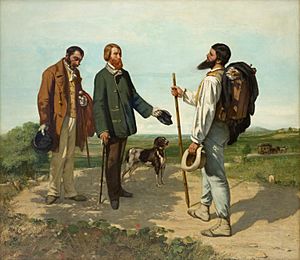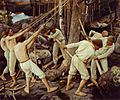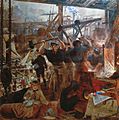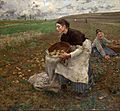Realism (arts) facts for kids

Realism in art means trying to show things as they really are. It avoids making things look fake or adding magical elements. People often use the word naturalism to mean the same thing, but they are a bit different.
Naturalism in art focuses on showing objects exactly as they appear. It tries to avoid any changes or distortions. This style became popular during the Renaissance in Europe. It grew with new ways of drawing, like linear perspective, which made flat pictures look three-dimensional.
Realism is a specific art movement that started in France after the French Revolution of 1848. Realist artists wanted to show everyday life, even the ordinary or difficult parts. They were interested in common people and new ideas about fairness in society. Artists like Gustave Courbet painted scenes that were not always beautiful. They rejected Romanticism, an art style that focused on strong emotions and imagination. Romanticism had been very popular in French art and writing since the late 18th century.
In the 1800s in Europe, "Naturalism" was sometimes seen as a separate part of Realism. This group tried to avoid talking about politics or social problems. They wanted their art to seem more scientific, like studying natural history.
Realism also appeared in other art forms. These include:
- Verismo in opera, which showed real-life stories.
- Literary realism, a style of writing that focused on everyday life.
- Theatrical realism, which made plays feel more true to life.
- Italian neorealist cinema, a film style showing real people and their struggles.
Images for kids
-
Lord Leighton's Cimabue's Celebrated Madonna of 1853–55 is at the end of a long tradition of illusionism in painting, but is not Realist in the sense of Courbet's work of the same period.
-
Bas-de-page of the Baptism of Christ, "Hand G" (Jan van Eyck?), Turin-Milan Hours. An advanced illusionistic work for c. 1425, with the dove of the Holy Ghost in the sky.
-
William Bliss Baker, American Naturalist painter, Fallen Monarchs, 1886
-
Pekka Halonen, Finnish Naturalist, Pioneers in Karelia, 1900
-
Diego Velázquez, The Farmers' Lunch, c. 1620
-
Giacomo Ceruti, Women Working on Pillow Lace, 1720s
-
Jean-Baptiste-Siméon Chardin, Woman Cleaning Turnips, c. 1738, Alte Pinakothek.
-
Jean-Baptiste Greuze, The Laundress, 1761
-
Albert Edelfelt, The Luxembourg Gardens. 1887
-
Gustave Courbet, The Stone Breakers, 1849
-
Jean-François Millet, The Gleaners, 1857
-
Honoré Daumier, The Chess Players, 1863
-
Jean-Baptiste-Camille Corot, Young Girl Reading, 1868
-
Jules Bastien-Lepage, October, 1878, National Gallery of Victoria
-
Ilya Repin, Religious Procession in Kursk Province, 1880–1883
See also
 In Spanish: Realismo artístico para niños
In Spanish: Realismo artístico para niños






























